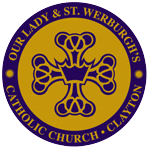A Benedictine and patroness
St Werburgh was a Benedictine and patroness of Chester, Abbess of Weedon, Trentham, Hanbury, Minster in Sheppey, and Ely. She was born in Staffordshire early in the seventh century and died at Trentham in 3rd February in 699 or 700.
St Werburgh was a King's daughter and a member of the Mercian household and had relatives in the French, Kentish and East Anglian Royal families. Her mother was St.Ermenilda, daughter of Ercombert, King of Kent, and St. Sexburga. Her father was Wulfhere, son of Penda, the fiercest of the Mercian kings.
St Werburgh was of Royal blood, however she cared not for the pretty things and the easy life associated with being a princess. Instead she longed only to do good and to make other people happy, and to grow good and wise herself. To do this St Werburgh studied and worked hard and became a holy woman and an Abbess.
St Werburgh had been attracted to the contemplative life and sought her father's permission to enter the abbey at Ely. Her father granted his daughter's wish although opposed at first. St Werburgh was consecrated abbess by Bishop Sexwulfus of Lichfield (675-691).
When her uncle Ethelrede succeeded her father as King of Mercia, he asked St Werburgh to take charge of all three monasteries of nuns in his dominion and bring them to a higher level of discipline and perfection.
Her work involved the reforming of the existing Mercian monasteries and the founding of new ones which King Ethelred generously endowed, namely, Trentham and Hanbury, in Staffordshire, and Weedon, in Northamptonshire.
Her position however did not change her humility that had always characterized her and in her devotion to all those in her care she was more a servant than the mistress. God rewarded her for her childlike trust by many miracles, which made St Werburgh one of the best known and loved Saxon saints.
One of the best known miracles was the command given by St Werburgh to a flock of geese causing havoc in the cornfields of Weedon. The command banished them and since then no geese have been seen in those parts.
St Werburgh instructed that she was to buried in Hanbury however the nuns of Threckingham (Trentham) refused to give up the body of St Werburgh until those of Hanbury took the body to the tomb in Hanbury. In 708 the body of St Werburgh was exhumed because of the many miracles associated with her. This was done in the presence of King Coelred of Mercia and his council. They found her body to be incorrupt and as it was when it had been laid to rest. In 875 the body was moved to Chester, the Church of St. Peter and St. Paul, which is the site of the present cathedral of Chester. It was rededicated to St. Werburgh and St. Oswald, most probably in the reign of Athelstan.
In 1093, Hugh Lupus, Earl of Chester, richly endowed the abbey and its church. Chester became a great Benedictine abbey, the name of St. Anselm, and then a monk at Bee was associated with this transformation.
During the vast wave of iconoclasm that swept over the country during the reign of Henry VIII many cathedrals were ransacked including Chester and St. Werburgh's relics were scattered, although they were later returned. Also, many of the figures in the Cathedral had been mutilated, and while restoring them the workmen by mistake placed female heads on male shoulders and vice versa. Only thirty of the original figures now remain, while four have been lost.
Our Lady and St Werburgh's Church has a statue of the Saint which also has a goose beside it. The statue itself was specially commissioned by Father Malcom Glaze when the church was converted from the orgiinal state to the present day church.
One version of the Legend is that St Werburgh had been interested in a flock of geese that visited the convent meadow and bathed in the pond in Weedon. One goose was her favourite and St Werburgh named him Grayking. He had a black ring around his neck and was the fattest and happiest looking of the flock.
Grayking was eaten by the convent steward, Hugh, because he looked very tempting and fat, but also because the flock of geese, which St Werburgh liked so much, had ruined his field of corn and he felt that they had not been punished enough by St Werburgh.
When St Werburgh found out this she was furious with the steward. She found the bones of the goose Grayking and ordered him to arise. The bones reformed and Grayking the goose stood before her.
Sources
- The Catholic Encyclopaedia, Volume XV
Copyright © 1912 by Robert Appleton Company - Online Edition
Copyright © 2003 by K. Knight - The Book of Saints and Friendly Beasts by Abbie Farwell Brown
Copyright (c) 2000-2004 Lisa Ripperton.
The Life of St Werburgh: Princess of Mercia by Ronald W. Bridgett
Copyright 1985 The Parish and Church Wardens of the Parish of St Werburgh,
Burslem, Stoke-on-Trent
